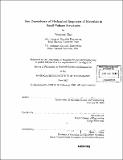| dc.contributor.advisor | Subra Suresh. | en_US |
| dc.contributor.author | Choi, Yoonjoon, 1967- | en_US |
| dc.contributor.other | Massachusetts Institute of Technology. Dept. of Materials Science and Engineering. | en_US |
| dc.date.accessioned | 2006-03-24T18:07:05Z | |
| dc.date.available | 2006-03-24T18:07:05Z | |
| dc.date.copyright | 2003 | en_US |
| dc.date.issued | 2003 | en_US |
| dc.identifier.uri | http://hdl.handle.net/1721.1/29964 | |
| dc.description | Thesis (Ph. D.)--Massachusetts Institute of Technology, Dept. of Materials Science and Engineering, 2003. | en_US |
| dc.description | Includes bibliographical references (p. 137-144). | en_US |
| dc.description.abstract | The effect of length scales on mechanical responses of materials in small-volume structures, such as thin films and patterned lines on substrates, is examined. The understanding of stress evolution and deformation behavior of those materials is one of major factors in the fabrication, performance, and reliability of microelectronic devices. The length scales involved in such materials are on the order of 1 min., and the deformation characteristics of the materials exhibit a strong dependence on their physical size such as film thickness and line width, as well as their microstructural length scale such as grain size. In this thesis, analytical, experimental, and computational approaches are utilized to elucidate the effect of length scales on the time-independent inelastic deformation of materials in small-volume structures. Experiments focus on continuous thin films and patterned lines of Al on Si substrates. The inelastic deformation of a material can be described by parameters which range from global constitutive (stress-strain) relations to atomistic descriptions of defect generation. An analytical model based on the generation of an array of dislocation loops is used to rationalize the film-thickness and grain-size effect on the stress evolution of thin metallic films on thick substrates. The consequence of the dislocation generation restricted by the film thickness and grain size leads to the full description of stress-temperature histories in an Al film on a Si substrate, which is subjected to thermal cycling, by incorporating the constitutive law of kinematic hardening. Systematic nanoindentation experiments on continuous thin films and patterned lines on Si substrates explore another length scale (line width) effect on the indentation load-displacement response. Computational modeling at the continuum (finite element analysis) and atomistic (molecular dynamics) levels presented herein provides insights into the origin of such size effects by correlating with the experimental observations. Based on the premise of dislocation-mediated deformation, such size effects on the mechanical responses of materials in small-volume structures arise from the equilibrium distribution of dislocations, which are tailored by the interaction of those dislocations with microstructural, physical length scales of materials, as well as various loading conditions. | en_US |
| dc.description.statementofresponsibility | by Yoonjoon Choi. | en_US |
| dc.format.extent | 144 p. | en_US |
| dc.format.extent | 5514870 bytes | |
| dc.format.extent | 9747528 bytes | |
| dc.format.mimetype | application/pdf | |
| dc.format.mimetype | application/pdf | |
| dc.language.iso | eng | en_US |
| dc.publisher | Massachusetts Institute of Technology | en_US |
| dc.rights | M.I.T. theses are protected by copyright. They may be viewed from this source for any purpose, but reproduction or distribution in any format is prohibited without written permission. See provided URL for inquiries about permission. | en_US |
| dc.rights.uri | http://dspace.mit.edu/handle/1721.1/7582 | |
| dc.subject | Materials Science and Engineering. | en_US |
| dc.title | Size dependence of mechanical responses of materials in small-volume structures | en_US |
| dc.type | Thesis | en_US |
| dc.description.degree | Ph.D. | en_US |
| dc.contributor.department | Massachusetts Institute of Technology. Department of Materials Science and Engineering | |
| dc.identifier.oclc | 54763336 | en_US |
